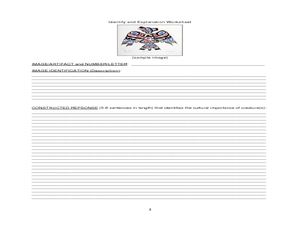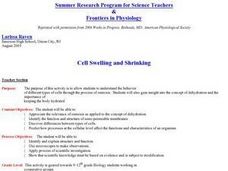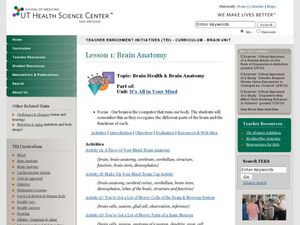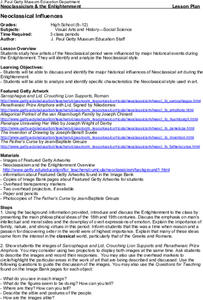Curated OER
Geometric Figures and the Coordinate Plane
Sixth graders explore geometric figures. In this geometry activity, 6th graders manipulate properties and relationships of geometric figures to identify objects on the coordinate planes and describe where figures sit on the planes.
Curated OER
Developing Effective Instructional Plans and Assessments in Mathematics
Students in a teacher education program develop a technology based lesson plan. After the lesson plan is created, they develop their own performance assessment. They identify the characteristics of good assessment instruments and model...
Curated OER
Leaf Arrangement: Kinetic Cognitive Connections
Students use critical thinking to identify leaf patterns. In this problem solving activity, student compare leaf patterns by "acting out" the positions and structures they see. This is a kinetic lesson where concepts are attained through...
Curated OER
Stories Behind Pacific Northwest First Nations' Images
Students investigate Canadian culture by examining mascots of the 2010 Olympics. In this Canadian history lesson, students read a Vancouver Olympics guide to identify three Canadian mascots and their importance to the First Nations...
Curated OER
Brain Health and Brain Anatomy
Students explore different intelligences. In this brain health lesson, students work through several activities to help them identify the type of intelligence they have. Students will focus on understanding their personal strengths and...
Curated OER
Cell Swelling and Shrinking
Students examine the concept of osmosis in relation to dehydration. They identify the function and structure of semi-permable membranes. They predict how certain processes can affect the characteristics of an organism.
Curated OER
Continents and Oceans
Students identify oceans and continents and their locations on a map. They color-code and label their own map of the world's continents and oceans. They play the game Continents and Oceans to identify specific areas.
Curated OER
Everybody Fiesta: A Unit on Hispanic Celebrations
Students examine the various types of celebrations in the Hispanic culture. Using the internet, they research customs and traditions of the culture and identify important members of society who are hispanic. They are also introduced to...
Curated OER
Brain Anatomy
Young scholars explore the brain. In this brain anatomy lesson plan, students explore the brain, identify the parts and neurons. They identify nerve pathways involved in daily activities.
Curated OER
Reading Word Recognition, Fluency, and Vocabulary
Eleventh graders analyze words that derive meaning from Greek, Roman, and Norse myths. In this myth vocabulary lesson, 11th graders work in learning groups as visual learners, kinesthetic learners, and artistic learners to identify the...
Curated OER
Marble Madness
Middle schoolers determine the velocity of a marble rolling down the incline. In this physics lesson plan, students identify the independent and dependent variables in the experiment. They construct and analyze a graph.
Curated OER
Waves
Students identify the different parts of a wave. In this physics lesson, students explain how animals communicate using sound waves. They discuss the effect of Navy's sonar on dolphins and whales.
Curated OER
Trade in the Ancient Mediterranean
Students begin the lesson by locating cities and other points of interest in the ancient world. In groups, they use the internet to research the types of ships used during this time period and discuss the reasons why trade was used. ...
Curated OER
Reader R.E.A.C.T.I.O.N.
Students practice their reading comprehension skills. In this reading skills lesson, students use the R.E.A.C.T.I.O.N. model to identify story elements in books that students elect to read independently.
Curated OER
Introduction to Earth's Dynamically Changing Climate
Learners identify the most common causes of global warming. In this earth science lesson, students use an interactive website to explore changes over time in sea ice, sea level, carbon emissions, and average global temperature. They take...
Curated OER
Social Studies, Civics Lesson
Students examine the development of government. They identify different theories of political thought around the world. They participate in a play to discover their own political views on key issues.
Curated OER
Creating An African Style Mask
Students investigate the different types of African masks that are found using the internet to perform research. They draw four different images based on the images downloaded. Students must cite sources used using MLA formatting.
Curated OER
Geo Jammin' By DeSign - Day 6, Lesson 32: Appliqué-tion of Learning
Second graders hand stitch three different appliqué stitches using triangles as a motif.
Curated OER
Design Details (Fashion Lingo)
Students identify and define fashion details that are used in garment design. They play Bingo with fashion detail terminology. They create a fashion sketch using fashion details and write an essay.
Curated OER
Neoclassical Influences
Students identify artists of the Neoclassical period and how they were influenced by major historical events during the Enlightenment as well as identify the Neoclassical style.In this Neoclassical art lesson, students discuss...
Curated OER
Fashion Terms
Young scholars listen to a lecture on fashion terms and define these words. They identify examples of terms in fashion magazines and take a quiz.
Curated OER
Fads and Classics
Students discuss the types of clothes they have worn and why they have gone out of style. After watching a PowerPoint presentation, they identify clothes that never go out of style and compare them to the fads. To end the instructional...
Curated OER
Construction Paper Straight Lines
Students actively identify types of line in the environment. They accurately demonstrate an understanding of how straight lines can be used in art. They learn a little about how artist get ideas and practice their skills in gluing.
Curated OER
Superb Sonnets
Young scholars identify and compare the characteristics of both Italian and English sonnets. They read examples of each, then write an original sonnet in either the Italian or English style.

























